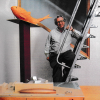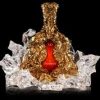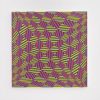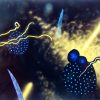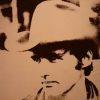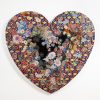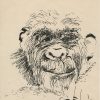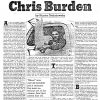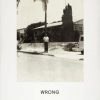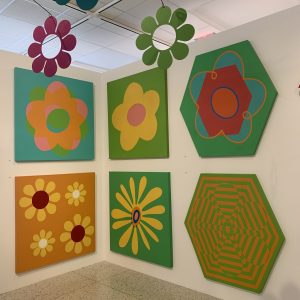
Jim Isermann installation detail at Palm Springs Architecture and Design Center
IF LIKE ME, you are longing to see art again, galleries in L.A. are opening slowly and by appointment. Prepare to be masked and prepare to be pleased at Soft Vibrations at Praz-Delavallade at 6150 Wilshire Blvd. losangeles@praz-delavallade.com
The group show includes two artists I’ve written about for decades, Jim Isermann and Roger Herman as well as textile artist Heather Cook. It is a tasty and clever combination of artists working with geometric patterns and shapes in painting, ceramic and textiles.
Before quarantine, I saw Isermann’s highly-focused show Copy. Pattern. Repeat. organized by curator Brooke Hodge the Palm Springs Architecture and Design. It was stunning and, though closed now, will open for a second viewing this fall. If you missed it, you’ll have another chance.
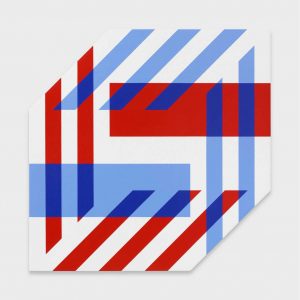
Jim Isermann, Untitled (3, 5, 7, in), 2018, acrylic on canvas over aluminum, 48 x 48 x 2 in., Collection of the Artist
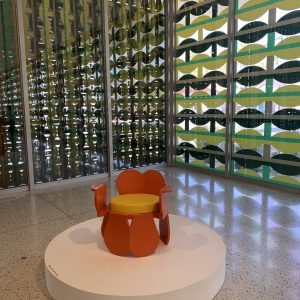
Jim Isermann installation detail at Palm Springs Architecture and Design Center
Meanwhile, you can see his geometric patterned paintings at the mid-Wilshire gallery. In either case, the work may be difficult to parse without some backstory. In Palm Springs, walls of the museum were lined with his 1980s glossy, brightly colored paintings while irreverent mobiles riff on the pop motifs of the flower power generation. He covered the windows of the 1966 Stewart Williams building with his own decal designs that wrapped the show in leafy green complementary to the architecture. There is an excellent article on the artist and the show by Steven Biller in Palm Springs Life. https://www.palmspringslife.com/jim-isermann/
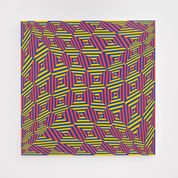
Jim IsermannUntitled (yellow 116,red 1788,blue 2728),2010-11 Acrylic latex paint on canvas over panel
Isermann’s geometric abstract paintings on view there have connections to ‘60s Op Art and that interest has evolved in the recent works on view at the gallery.
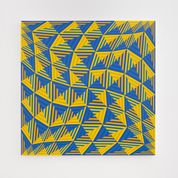
Jim Isermann, Untitled (light yellow 116,dark yellow 124,blue 285,dark blue 2728),2011Acrylic latex paint on canvas over pane
In an online viewing room, they seem simple. Far from it. Isermann paints them by brush, by hand, after working out the designs on grid paper, as he has done since the 1980s. With informed joy, they pay homage to the origins of geometric hard-edge painting.
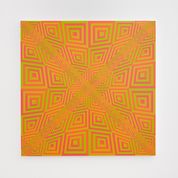
Jim Isermann, Untitled (orange 21,ochre 124,green 397,red 1788),2009 Acrylic latex paint on canvas
More significantly, they are rooted in his own, highly personal, fascination with early modern art and design. Furniture, textiles, chandeliers, clocks, seating arrangements and more were crafted by Isermann in the early ‘80s as a way of exploring the ideas and materials of early modernist art and design that had fallen out of favor. In 1982, with gallerist Richard Kuhlenschmidt, he furnished a room at the Inn of Tomorrow in Anaheim with his own furnishings, bed coverings and wall decorations as a nod to the once futuristic aspirations of a faded ‘60s era motel. (No surprise that he was friends with Jeffrey Vallance, that other inveterate explorer of cultural history of So Cal and beyond.)Both are profiled in this Artnews story from 1986. http://hunterdrohojowska-philp.com/wp-content/uploads/1986/05/Scan-Mar-12-2020-at-12.46-AM.pdf

Jim Isermann, Motel Modern, Inn of Tomorrow, 1982
Isermann’s ’70s graduate studies at CalArts put him in touch with Feminist teachers and the use of textiles as gender bending alternatives to paint. I wrote about those influences in this 1994 LA Times profile. http://hunterdrohojowska-philp.com/wp-content/uploads/2016/11/Jim_Isermann_LA_Times.pdf.
Instead of purifying painting, following the thinking of Clement Greenberg, Isermann dissolved the line between form and function.

By extension, Roger Herman broke from his usual exploration of the figure to paint squares and rectangles of muted color on large lumpen clay pots.
Poised on their pedestals, they dance with Isermann’s clean cut aesthetic.
 Celebrated for his expressionist paintings and prints, Herman has been hailed for his unconventional ceramics, rebels against the notion of high craft. http://hunterdrohojowska-philp.com/wp-content/uploads/2016/10/Roger_Herman_artnet.pdf
Celebrated for his expressionist paintings and prints, Herman has been hailed for his unconventional ceramics, rebels against the notion of high craft. http://hunterdrohojowska-philp.com/wp-content/uploads/2016/10/Roger_Herman_artnet.pdf
Heather Cook, on the otherhand, is painstaking in her attention to applying color to threads then woven into intricate zig zag patterns, a method of exploring geometry and edge in an uncharacteristically soft medium.

Heather Cook, Shadow Weave Fluorescent Blue + Scarlet (5116) 8/2Cotton 20EPI,2020
Soft Vibrations, indeed.
Altogether, this is a group show to uplift at a time when it is most needed. It continues through September.
